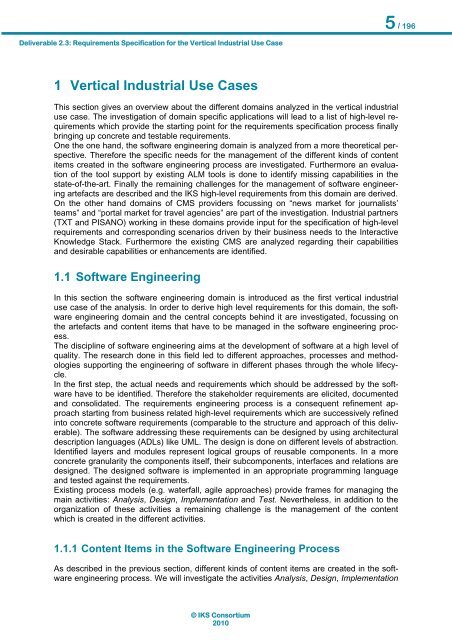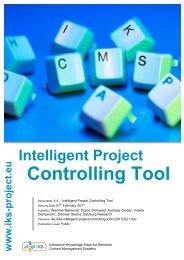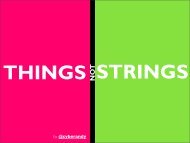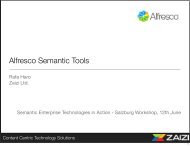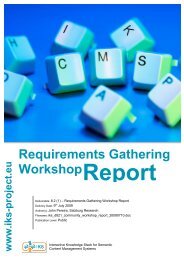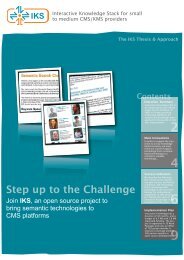Requirements Specification of the Vertical Industrial Use Case ... - IKS
Requirements Specification of the Vertical Industrial Use Case ... - IKS
Requirements Specification of the Vertical Industrial Use Case ... - IKS
Create successful ePaper yourself
Turn your PDF publications into a flip-book with our unique Google optimized e-Paper software.
5 / 196Deliverable 2.3: <strong>Requirements</strong> <strong>Specification</strong> for <strong>the</strong> <strong>Vertical</strong> <strong>Industrial</strong> <strong>Use</strong> <strong>Case</strong>1 <strong>Vertical</strong> <strong>Industrial</strong> <strong>Use</strong> <strong>Case</strong>sThis section gives an overview about <strong>the</strong> different domains analyzed in <strong>the</strong> vertical industrialuse case. The investigation <strong>of</strong> domain specific applications will lead to a list <strong>of</strong> high-level requirementswhich provide <strong>the</strong> starting point for <strong>the</strong> requirements specification process finallybringing up concrete and testable requirements.One <strong>the</strong> one hand, <strong>the</strong> s<strong>of</strong>tware engineering domain is analyzed from a more <strong>the</strong>oretical perspective.Therefore <strong>the</strong> specific needs for <strong>the</strong> management <strong>of</strong> <strong>the</strong> different kinds <strong>of</strong> contentitems created in <strong>the</strong> s<strong>of</strong>tware engineering process are investigated. Fur<strong>the</strong>rmore an evaluation<strong>of</strong> <strong>the</strong> tool support by existing ALM tools is done to identify missing capabilities in <strong>the</strong>state-<strong>of</strong>-<strong>the</strong>-art. Finally <strong>the</strong> remaining challenges for <strong>the</strong> management <strong>of</strong> s<strong>of</strong>tware engineeringartefacts are described and <strong>the</strong> <strong>IKS</strong> high-level requirements from this domain are derived.On <strong>the</strong> o<strong>the</strong>r hand domains <strong>of</strong> CMS providers focussing on “news market for journalists’teams” and “portal market for travel agencies” are part <strong>of</strong> <strong>the</strong> investigation. <strong>Industrial</strong> partners(TXT and PISANO) working in <strong>the</strong>se domains provide input for <strong>the</strong> specification <strong>of</strong> high-levelrequirements and corresponding scenarios driven by <strong>the</strong>ir business needs to <strong>the</strong> InteractiveKnowledge Stack. Fur<strong>the</strong>rmore <strong>the</strong> existing CMS are analyzed regarding <strong>the</strong>ir capabilitiesand desirable capabilities or enhancements are identified.1.1 S<strong>of</strong>tware EngineeringIn this section <strong>the</strong> s<strong>of</strong>tware engineering domain is introduced as <strong>the</strong> first vertical industrialuse case <strong>of</strong> <strong>the</strong> analysis. In order to derive high level requirements for this domain, <strong>the</strong> s<strong>of</strong>twareengineering domain and <strong>the</strong> central concepts behind it are investigated, focussing on<strong>the</strong> artefacts and content items that have to be managed in <strong>the</strong> s<strong>of</strong>tware engineering process.The discipline <strong>of</strong> s<strong>of</strong>tware engineering aims at <strong>the</strong> development <strong>of</strong> s<strong>of</strong>tware at a high level <strong>of</strong>quality. The research done in this field led to different approaches, processes and methodologiessupporting <strong>the</strong> engineering <strong>of</strong> s<strong>of</strong>tware in different phases through <strong>the</strong> whole lifecycle.In <strong>the</strong> first step, <strong>the</strong> actual needs and requirements which should be addressed by <strong>the</strong> s<strong>of</strong>twarehave to be identified. Therefore <strong>the</strong> stakeholder requirements are elicited, documentedand consolidated. The requirements engineering process is a consequent refinement approachstarting from business related high-level requirements which are successively refinedinto concrete s<strong>of</strong>tware requirements (comparable to <strong>the</strong> structure and approach <strong>of</strong> this deliverable).The s<strong>of</strong>tware addressing <strong>the</strong>se requirements can be designed by using architecturaldescription languages (ADLs) like UML. The design is done on different levels <strong>of</strong> abstraction.Identified layers and modules represent logical groups <strong>of</strong> reusable components. In a moreconcrete granularity <strong>the</strong> components itself, <strong>the</strong>ir subcomponents, interfaces and relations aredesigned. The designed s<strong>of</strong>tware is implemented in an appropriate programming languageand tested against <strong>the</strong> requirements.Existing process models (e.g. waterfall, agile approaches) provide frames for managing <strong>the</strong>main activities: Analysis, Design, Implementation and Test. Never<strong>the</strong>less, in addition to <strong>the</strong>organization <strong>of</strong> <strong>the</strong>se activities a remaining challenge is <strong>the</strong> management <strong>of</strong> <strong>the</strong> contentwhich is created in <strong>the</strong> different activities.1.1.1 Content Items in <strong>the</strong> S<strong>of</strong>tware Engineering ProcessAs described in <strong>the</strong> previous section, different kinds <strong>of</strong> content items are created in <strong>the</strong> s<strong>of</strong>twareengineering process. We will investigate <strong>the</strong> activities Analysis, Design, Implementation© <strong>IKS</strong> Consortium2010


